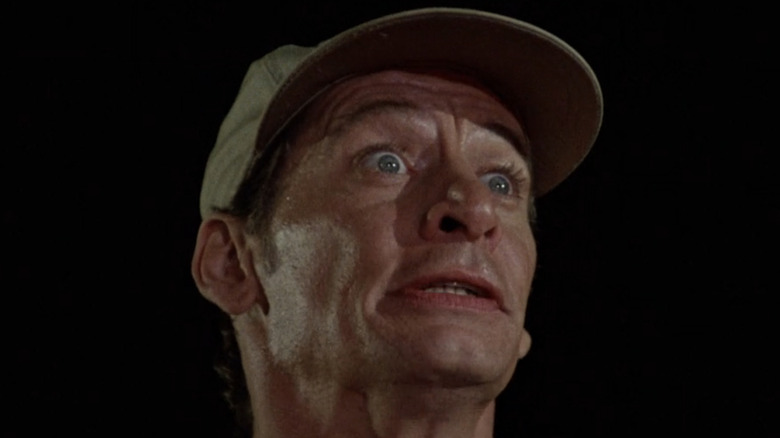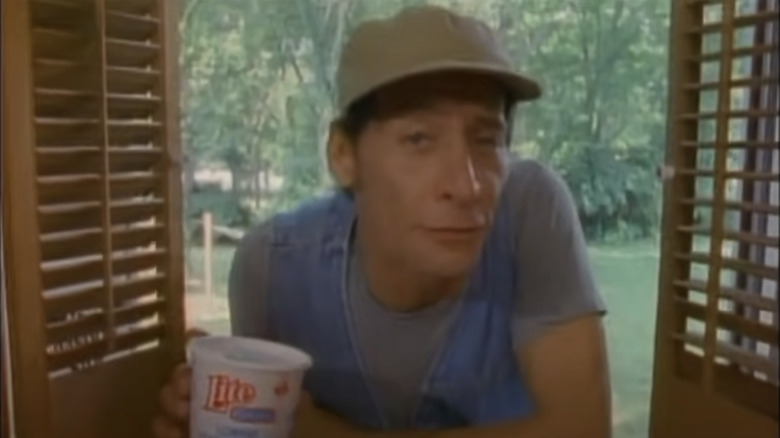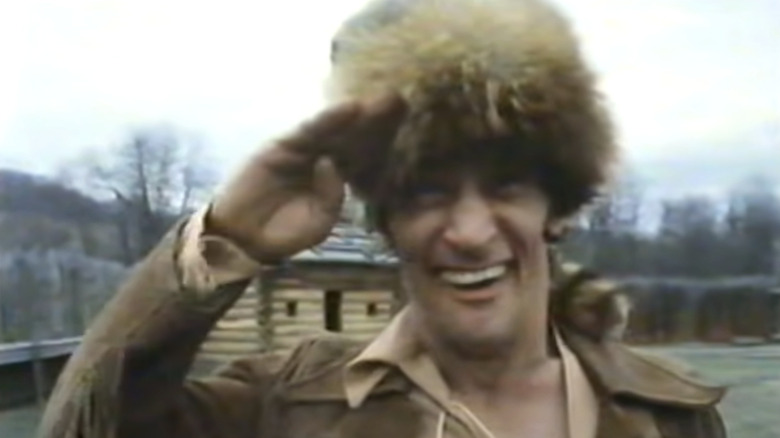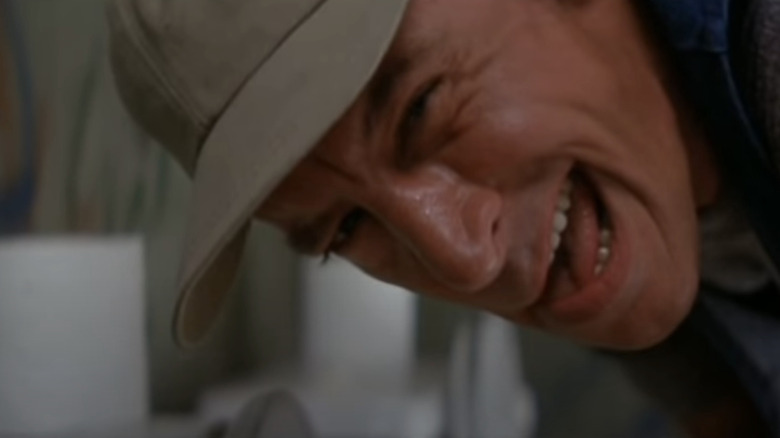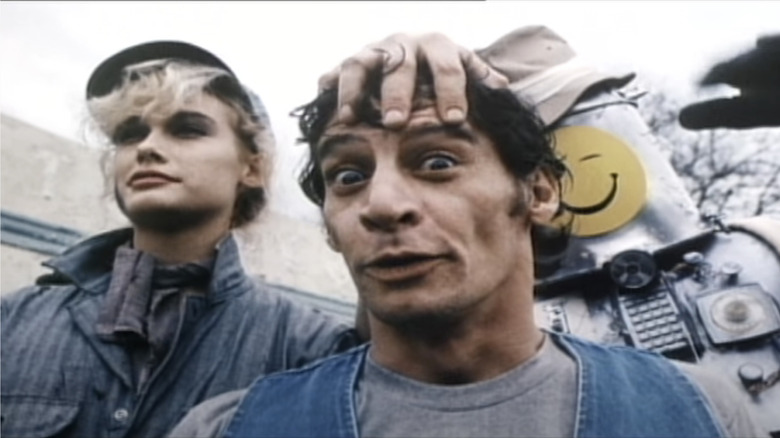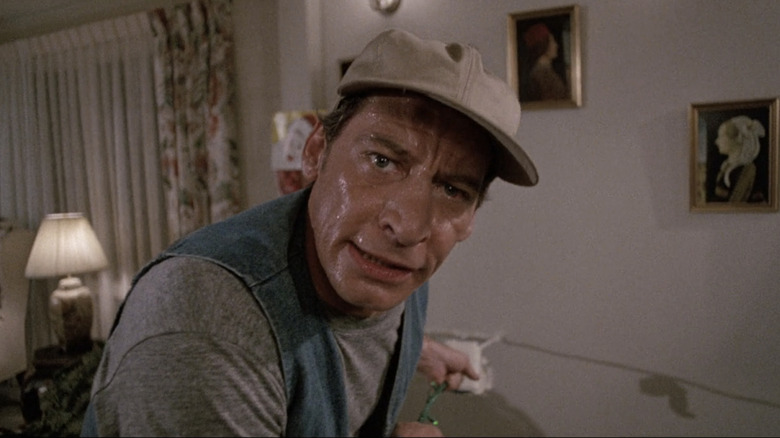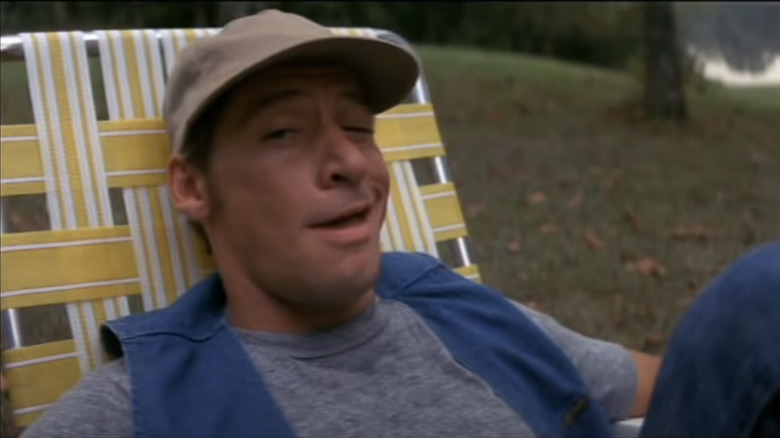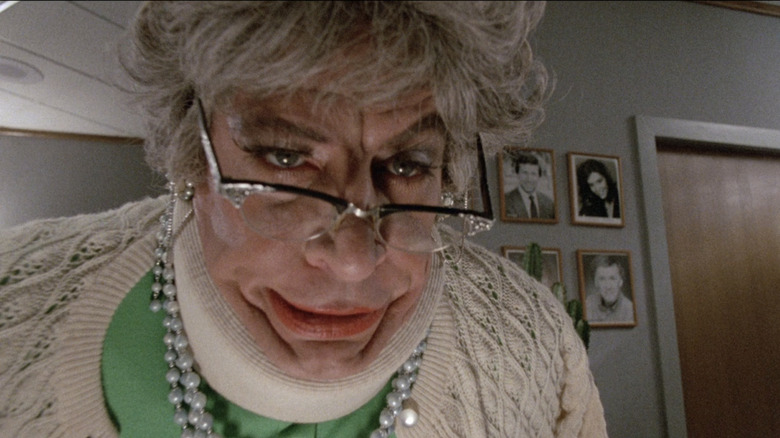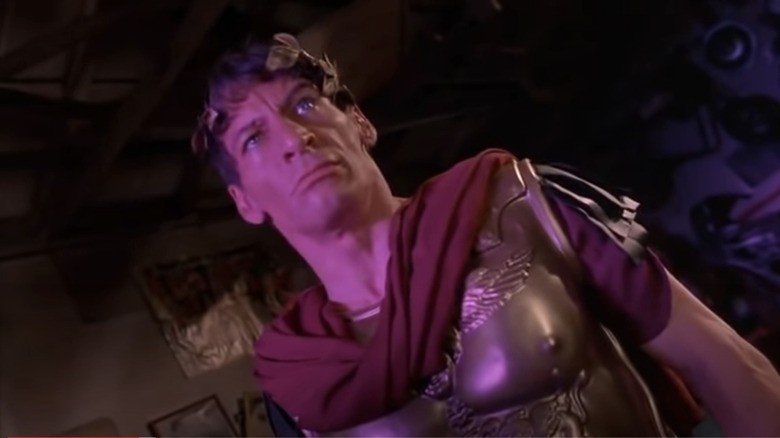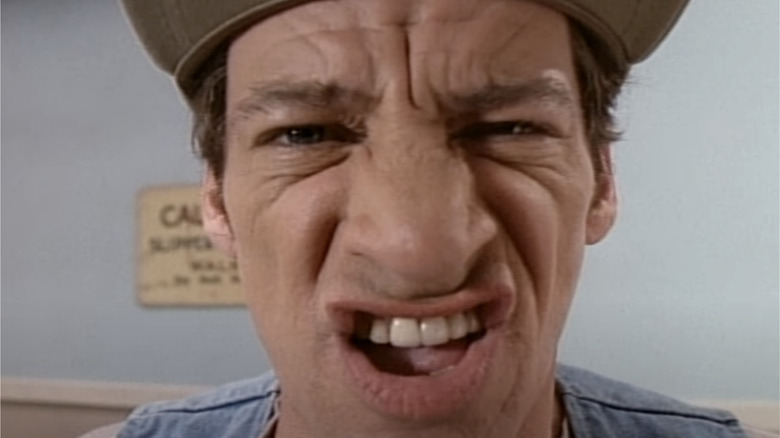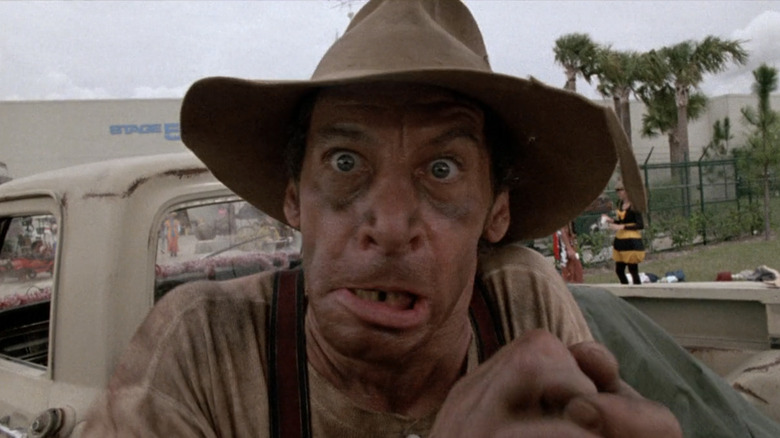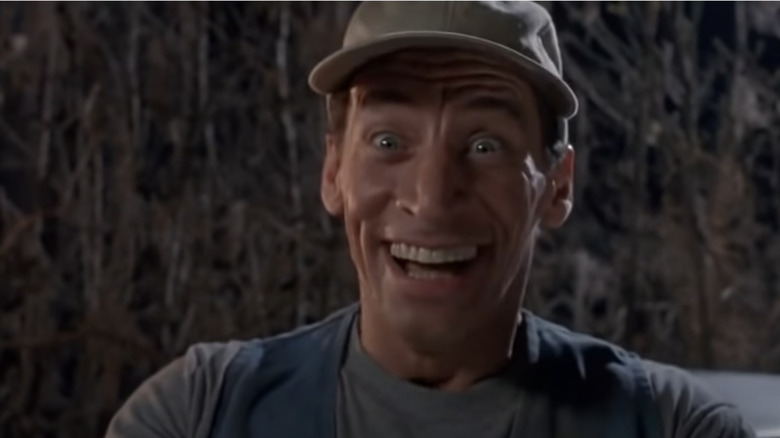The Untold Truth Of The Ernest Movies
We may receive a commission on purchases made from links.
There was a time in the United States — let's call it the 1980s — when Ernest P. Worrell was inescapable. He was in our commercials, selling everything from ice cream to natural gas in dozens of markets across the country. He was on our Saturday morning TV with his own kid-friendly sketch comedy show. He was in our hometown parades, our bookstores, and waiting in line with us at Disneyworld. And from 1987 to 1998, he was on our movie screens and in our video stores with a series of high-concept feature films, where his endearing and irritating (often at the same time) antics helped him save Christmas, go to jail, slam dunk, and ride again.
The brainchild of Nashville advertising executive turned Hollywood director John R. Cherry and Kentucky-born comic actor Jim Varney, Ernest was someone that just about everyone knows, a know-nothing know-it-all whose unsolicited advice to his never-seen neighbor Vern always ends in calamity for one or both of them. No one can ride the zeitgeist forever, though, and a combination of waning public interest and personal tragedy put the Ernest series to bed by the end of the 1990s. Though both Varney and Cherry have now passed away, their work lives on. Here are some things you might not know about the Ernest movies.
Carden and Cherry
In 1980, John R. Cherry III was an executive at Carden and Cherry, an advertising agency headquartered in Nashville, Tennessee, working on a television ad campaign for Beech Bend Park in Bowling Green, Kentucky. The park had fallen into disrepair and did not make a good visual impression, so rather than show footage of the park in the commercial, Cherry hit on the idea to have a character on screen talk up the park experience to an unseen companion — unseen, as Cherry revealed in an interview with digital marketing consultant Scott Murray in 2013, because they didn't have the budget to hire a second actor.
Cherry's initial idea for the character boiled down to "Whatever deal you have, he has a better deal. He's annoying, he's a guy next door, and he's always in your face about something." Cherry's inspiration came from a close source: His own father. "I had all my life training to develop Ernest," he joked in 2013. Now that he had the idea for the commercial and the character nailed down, he just needed an actor to perform it.
Starring Jim Varney
Enter Kentucky-born stage and television actor Jim Varney. Prior to taking the job with Carden and Cherry, Varney had spent several years taking small television roles, most notably on the Norman Lear-created talk show parody "Fernwood Tonight" and its spinoff "American 2-Nite," as well as the short-lived 1977 adaptation of the Cary Grant submarine comedy "Operation Petticoat." Varney told entertainment journalist Buzz McClain that he was paid just $300 for that first Beech Bend Park commercial, and had to pay for his own gas to get to Nashville from Louisville.
Despite both of them being Southern and sharing a lanky, rubber-faced physicality, Varney was very different from his commercial alter ego. With a memory director Coke Williams described as photographic to Nashville Scene, Varney knew he wanted to be an actor from an early age. He poured his energies into developing characters that would later become part of the Ernest canon, like hard-as-nails drill instructor Sgt. Glory and terminally unimpressed Auntie Nelda. At Barter Theatre in Virginia he studied Shakespeare; in a 1993 Los Angeles Times profile, one of his former Barter co-stars, Walter Williamson, lamented that the role of Ernest had taken over Varney's career so thoroughly. "I would love to see him utilize all his talents," Williamson said. "He's got an amazing instrument."
Knowhutimean?
No one quite knew what to do with Ernest after those first Beech Bend Park commercials, viewers especially. "Oh, when we first started they hated him, just hated him!" Cherry recalled in a 1990 profile for Entertainment Weekly. But a few of Carden and Cherry's clients took a liking to the obnoxious character. Nashville-based dairy company Purity Dairy and Oklahoma ice cream maker Braum's used Ernest as their pitchman for the better part of a decade. When he was hawking Toyotas for a Virginia dealership, people would call the dealership just to find out what time their ads would be playing.
At the beginning, Cherry and his team focused on local markets in the South, assuming that Ernest's good ol' boy persona would only work there. But it turns out that there's an Ernest in every corner of the country, and before long he was playing in more than 200 markets. The advertisements followed a fairly strict structure, with Ernest butting in on his next door neighbor Vern, often at home, talking up the featured product or service, then suffering some pratfall that injured himself and/or destroyed something of Vern's. His sentences would often be punctuated with a "Know what I mean?" — or rather, "Knowhutimean?" — which quickly became a well-worn catchphrase, along with his Steve Martin-esque "Ewwww-hewwwwwwww" sound of disgust. Perhaps the best creative choice Cherry made was the one first born out of necessity: Making "Vern" an unseen character represented by the camera, making the audience an unwitting scene partner to Ernest's antics, and thus giving them permission to be both entertained and annoyed by the character.
The Ernest Movies No One Remembers
In 1983, Cherry and Varney put together a one-hour television special, "Hey Vern, It's My Family Album," in which Ernest corners Vern up on his roof and forces him to hear stories about all of the Worrell ancestors. That framing device kept the popular Ernest character in play while allowing Varney to flex his character muscles, playing each historical Worrell in short comedy sketches, as when frontier ancestor Davy Worrell pretends to be an entire fort's worth of soldiers in order to hold back a Native war party. Speaking to the Nashville Scene years later, Cherry called it "our favorite," even though it wasn't widely seen. "The syndication on it was weak, and we were green."
Two years later, Cherry tried his hand at writing and directing a feature film, which ended up being even more obscure than "Hey Vern, It's My Family Album." "Dr. Otto and the Riddle of the Gloom Beam" was a low-budget sci-fi comedy produced by the Carden and Cherry agency, and like "Family Album," featured Varney in a variety of roles — including the eponymous mad scientist, whose gloom beam is used to disrupt the world's economy. A high-tech contraption known as the "changing coffin" allows Dr. Otto to transform into different likenesses, including Ernest in the film's final scene. Though Ernest has little to do in the film, the appearance of the character became a major selling point, as seen in its Ernest-centric promotional art.
Ernest Mania
Despite those two less-than-successful attempts to make the leap from commercials to film, Ernest's star continued to rise throughout the mid-1980s, to the delight and confusion of Cherry and Varney. When asked what makes Ernest so appealing in a 1984 CBS Evening News segment, Cherry replied with a laugh, "Beats me! It amazes me every day!" When CBS ran a second segment on Ernest just a year later, Cherry's response to the same question was a little more thoughtful: "He's a cult figure for middle America. They'd say, 'You know, I may be on the bottom of the heap, but I'm above that guy.'"
During those years, the best of Ernest's 2,000 commercial appearances were collected into a VHS series. Ernest found himself in bookstores in 1986 with "The Ernest P. Worrell World Book of Knawledge." Varney made public appearances in character all over the country, and even made it to the White House for a belated April Fools Day joke, introduced during a press briefing as the Reagan administration's new chief economist. But it was an appearance at the Indianapolis 500 in 1986 that marked a turning point for both Varney and his alter ego. Cherry recalled to the Los Angeles Times that, during the race, Ernest rode in a pace car alongside Mickey Mouse ... and Ernest got the bigger reaction from the crowd. When you upstage Mickey Mouse, people are bound to take notice, and two people in particular did: Film executives Michael Eisner and Jeffrey Katzenberg, who had recently taken the reins at Disney.
Ernest Goes to Hollywood
Disney produced four Ernest films under their Touchstone Pictures subdivision from 1987 to 1991. The first, "Ernest Goes to Camp," was an experiment. Despite, or perhaps because of, "Family Album" and "Dr. Otto," no one knew quite what an Ernest movie might look like, expanding a thirty-second character into a ninety-minute feature. The film was directed by Cherry and produced on a shoestring budget, just over $3 million. The plot, in which Ernest tries to save the summer camp he works at from a greedy mining company, was chosen mostly for mercenary reasons. Cherry told digital marketing consultant Scott Murray that a summer camp would be cheap to film at, and the success of other camp comedies like "Meatballs" made the film an easy sell to Disney.
The film was a modest hit on a shoestring budget, which earned Cherry and Varney enough goodwill at Disney to keep striking while the iron was hot. Any number of Ernest sequel ideas were pitched, but the one that won the day was a holiday feature in which Ernest gets mixed up with an aging Santa Claus' search for a successor. "Ernest Saves Christmas" was rushed into production and released just a year after "Camp." While most of the Ernest oeuvre thus far had been made in and around Nashville, for his first sequel, Ernest would ditch Music City for a sunnier, happier locale.
Ernest Goes to Disneyworld
Michael Eisner and Jeffrey Katzenberg didn't just distribute Varney and Cherry's films; they made Ernest a full-fledged resident of the Mouse House. In 1989, Ernest volunteered to be the first "splashtronaut" aboard the then-new Disneyland water ride Splash Mountain in a 30-minute television special. That same year, the Epcot attraction Cranium Command opened at Disneyworld in Orlando, and its pre-show video used a picture of Ernest as an example of a cranium that was not quite in command.
"Ernest Saves Christmas" practically served as an advertisement for Orlando, filming on location across the city, from the airport to the former Orlando Science Center. Production made use of the brand new Disney-MGM Studios, which at the time was an actual working film studio in addition to being a theme park. The scene in which Ernest wrecks Vern's house while trying to deliver a Christmas tree was filmed in part at the park's Residential Street, a row of exterior-only houses used as establishing shots for various film and TV projects, most notably "Empty Nest" and "The Golden Girls." Long part of the park's Studio Backlot tour, Residential Street was torn down in the early 2000s to make way for the Lights Motors Action Extreme Stunt Show, which in turn was demolished along with the remainder of the Studio Backlot tour in 2016 to make way for the park's (now known as Disney Hollywood Studios) new "Toy Story" and "Star Wars" attractions.
Highs and Lows
"Ernest Saves Christmas" was a bigger hit than "Camp," earning $28 million in theaters on a $6 million budget, even if its reviews were less than stellar. But as the movie played in theaters, a different Ernest project, and arguably the character's most artistically successful endeavor, was playing Saturday mornings on CBS. The kids' sketch comedy series "Hey Vern, It's Ernest!" returned Ernest to his roots, adapting the structure of "Hey Vern, It's My Family Album" but at a more manic pace. Varney once again played multiple characters, including mainstays like Auntie Nelda and even bringing back Dr. Otto. The one-season wonder won Varney a Daytime Emmy, just a year after he had won a Razzie for "Ernest Goes to Camp."
1990 and 1991 saw the third and fourth Ernest movies produced by Touchstone, "Ernest Goes to Jail" and the Halloween release "Ernest Scared Stupid." While "Goes to Jail" earned well at the box office, better than "Camp" but not quite as good as "Christmas," reviews for the film were atrocious. Reviews for "Scared Stupid" were marginally better, but not even the presence of Eartha Kitt as a local mad scientist helping Ernest defeat an ancient troll could save the movie from bombing; it earned $10 million less than "Ernest Goes to Jail" the previous year.
Direct to Video
"Ernest Scared Stupid" would be the last Ernest film distributed by Disney via Touchstone. For 1993's "Ernest Rides Again," a buddy road comedy involving the crown jewels of England, Cherry produced and distributed the film independently, returning to something closer to the character's early days after four increasingly high concept features. Unfortunately, the film disappeared from theaters with barely $1.5 million in ticket sales, and the remaining films in the series –- "Ernest Goes to School," "Slam Dunk Ernest," "Ernest Goes to Africa," and "Ernest in the Army" — would be released direct to video. Cherry and Varney would also make a sequel of sorts to "Hey Vern, It's My Family Album" in 1994's short film "The World as I See It," featuring Varney's usual menagerie of kooky characters.
As the series moved from film to VHS, both Cherry and Varney began to stretch beyond Ernest. In 1999, Cherry attempted to revive the classic 1930s comedy team Laurel and Hardy with "Ernest" side player Gailard Sartain and "Perfect Strangers" star Bronson Pinchot. Varney, meanwhile, starred in the 1993 feature adaptation of the 1960s sitcom "The Beverly Hillbillies" and voiced Slinky Dog in the first two "Toy Story" films. In the '90s, he dipped his toes back into more mature, dramatic work, but a series of health crises sadly put an end to those plans. Varney died of lung cancer in 2000; his last onscreen role was in the Billy Bob Thornton-penned comedy "Daddy and Them," which was released posthumously in 2001.
The Movies That Never Were
A character as endlessly malleable as Ernest could literally go anywhere and do anything, which meant that there were a great many movie ideas that came and went over the years. In 1990, on the eve of the release of "Ernest Goes to Jail" — arguably at the character's peak of cinematic popularity – Entertainment Weekly reported on some sequel ideas that Cherry had in the mix These included the original pitch of "Ernest Scared Stupid," which involved Ernest inheriting a haunted house, "Ernest and the Voodoo Curse," which may have involved Ernest saving a virgin from a human sacrifice, and an "E.T.: The Extra-Terrestrial" knock-off that would have been called "Ernest and the Water Baby."
Sending Ernest into space was a perennial sequel idea that never quite worked out, budget-wise, alternately pitched as "Ernest Spaced Out" or simply "Ernest in Space." Speaking to the Buffalo News while promoting "Jail," Varney also pitched a superhero-parody sequel called "The Bold Crusader," where Ernest would be an exterminator who stumbles into the Crusader's secret lair. While there are echoes of "Ernest and the Voodoo Curse" in "Ernest Goes to Africa," notably in giving Ernest a love interest and some truly unfortunate bit of race-based humor, none of the direct to video sequels have the ambition of these scrapped ideas. And now that both Cherry and Varney have passed away, it is unlikely that we'll ever see Ernest on screen ever again.
Ernest Gets a Reboot?
Unlikely, but not impossible. In October 2012 Variety reported that producer Clarke Gallivan, who had worked on "Dr. Otto" and "Ernest Goes to Jail," was teaming up with longtime "Ernest" producer (and "Ernest Goes to School" director) Coke Sams to make a reboot titled "Son of Ernest." The film would have followed Ernest's long-lost son, now an adult, following in his father's pratfalls. The movie news website firstshowing.net picked up Variety's story and even published a press release image they had received which parodied the poster for "The Bourne Legacy." Screenwriter Dan Ewen reached out to the site by email to confirm that he had been tapped to write the reboot, joking that "I accept this charge knowing the risks, and fully aware that my family could disown me if the resulting cinematic experience is less than pure genius."
Nearly a decade later, however, there has been little movement on the project. In a 2019 interview with the Athens Banner-Herald, Ewen confirmed that "Son of Ernest" was still in development, dreaming of a film so cool that it beguiles the hipster audiences at South by Southwest — though perhaps he should listen to John Cherry, who once pinned Ernest's appeal to the fact that he is decidedly uncool. "Every time we do a study on who Ernest appeals to, it's the under-13 and over-35 age groups," Cherry told Entertainment Weekly in 1990. "If you're under 13, it's OK, and when you're over 35, you know it doesn't count anymore — you don't have to be cool."
